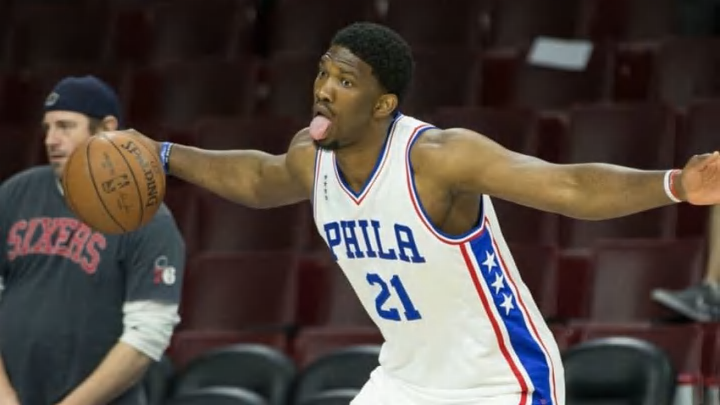
We know that Bryan Colangelo wants to add veterans to the roster. But in a “get wins now” mode, would Bryan Colangelo trade Joel Embiid?
Sacred cow. An idea, custom, or institution held, especially unreasonably, to be above criticism (with reference to the Hindus’ respect for the cow as a sacred animal).
If you have followed the events of the Philadelphia 76ers for the past two plus years, you know that the team has been capable of putting any player on the trading block, if they increased in value above the worth to the 76ers, and if someone offered them an equivalent value above that price. Two such promising careers in a Philadelphia 76ers jersey ended in that fashion – point guard Michael Carter Williams, and shooting guard/small forward K.J. McDaniels, but not ever Joel Embiid. Joel Embiid, for lack of a better term, was a sacred cow in the Sam Hinkie era.
But is that true going forward?
Michael Carter-Williams was the solution at point guard to the new general manager, and played so well that he earned NBA Rookie of the Year in 2014. But even while winning the prestigious award, his value to the NBA was climbing rapidly, while his fit in the Sixers scheme was declining. He was a scorer, but a scorer on volume, not on accuracy. From the point guard position, the team was truly seeking a high accuracy, selfless feed to the other four players. What they got in MCW was a guy who took the ball to the hoop. What they needed was a perimeter shooter who could handle the ball. MCW shot 26% on jumpers (last in the NBA), and lost the ball on average 4.2 turnovers per game. Not the best fit. And so, Sam Hinkie traded him in a heartbeat to get the Los Angeles Lakers first round protected pick that has yet to convey.
Meanwhile Williams was relegated to the bench for the Milwaukee Bucks this past year, and had season ending hip surgery announced in March 2016.
More from Sixers News
- 3 Sixers players who could help Team USA Basketball
- 76ers 2k24 ratings: 3 most underrated players on Philadelphia roster
- 76ers head coach Nick Nurse bares lofty plans for Paul Reed this season
- Grade the Trade: 76ers swap Tobias Harris for superstar PG in mock deal
- Breaking Down Bombshell Report on Sixers Star James Harden
Another solid performer was wing man K.J. McDaniels, a solid contributor for the Philadelphia 76ers. After playing far greater than his second round drafted selection would have expected, he was traded to the Houston Rockets for Isaiah Canaan and a second round pick. While he was a Sixer, McDaniels electrified the crowd with highlight reel dunks, but he would only consent to sign a one year deal with the Sixers. McDaniels believed a short one-year deal would lead to a far more lucrative contract on the next signing – which happened to be a three year $10 Million dollar deal he inked with the Houston Rockets. Unfortunately for McDaniels, that deal only covered him for about half the season. He did not show much as a Houston Rocket, and he was assigned to their Development league team, the Rio Grande Valley Vipers.
So as far as the former President Sam Hinkie’s track record, he traded two key players who failed to perform to expectations with their new team.
Next: Embiid is, er, Was Safe
